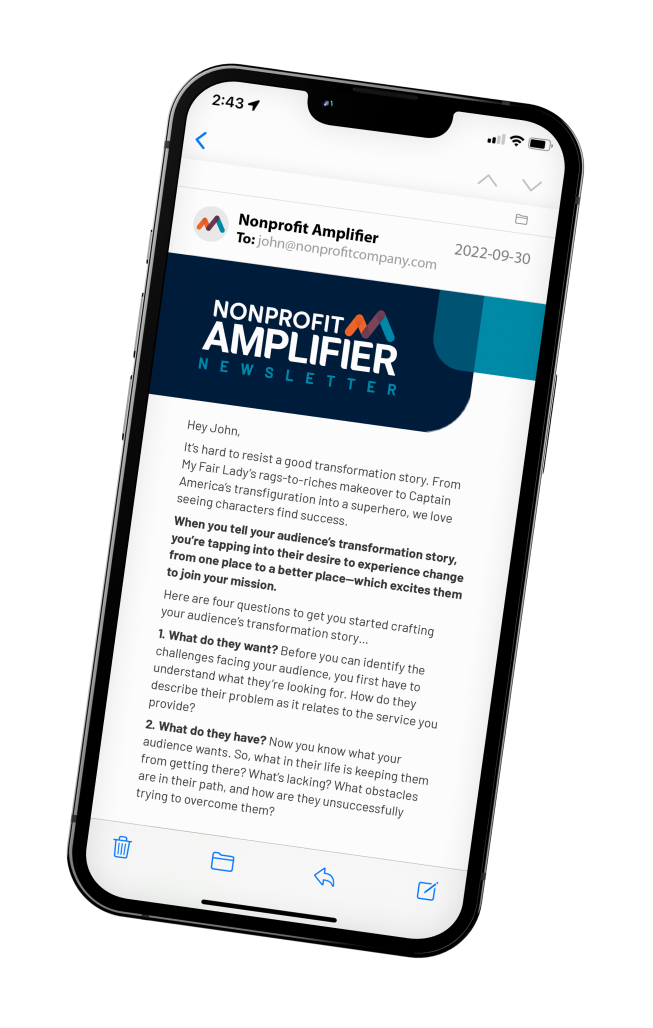How to Collect and Use Your Existing Audience Stories
Reading time: 4 minutes
Nothing sticks in your head quite like a story.
Some of the most important and powerful stories you should be telling are the ones of people who have already experienced the transformation your nonprofit provides (a.k.a. testimonials).
Testimonials activate a trigger inside the reader. When they see that you've helped others achieve the desired outcome, your audience believes they can achieve that outcome, too. And they want you to help.

These stories provide the social proof people need to trust you.
As a nonprofit, you likely have two audiences: those you serve and those serving your organization through donating, volunteering, or some other means. So make sure you are sharing stories from both groups!
But you can’t just share any testimonials…
“They were great!” = the worst testimonial ever.
Testimonials need to say something meaningful, which means you need to help craft the testimonials you get from your audiences (ethically, of course). There are two ways to do this:
1. Speak to the problem, solution, and result of existing supporters and benefactors.
I was experiencing _____,
then I discovered _____,
and now my life is _____.
For example: “I have struggled with disordered eating. Your organization gave me the resolve I needed to win back my life. Now I’m getting more physically and mentally strong everyday with a supportive community of friends and family.”
2. Speak to specific objections that your audience might have.
I was skeptical about _____,
but then I tried _____,
and now I know _____.
For example: “I didn’t think I could sponsor a child until I traded eating out once a month to cover the cost. Now I cherish the letters I get from my sponsored child more than any meal I could eat out.”
The more you weave these stories into all the places you're speaking to your people (e.g., website, emails, social media, ads, videos, etc.), the more powerful your message will be.
However, getting testimonials that say something more than “They’re great!” can feel like asking my five-year-old to eat broccoli.
So, rather than asking your audience to start from a blank slate—which is intimidating for most people—use the framework and questions below to draw out a compelling transformation story.
First, prime the pump. Remind your recipient/donor/volunteer of what you did together and why you enjoyed working with them. Then ask them if they would answer a few questions to be used as a testimonial to help others.
If they agree, send them these key questions (tailored to your nonprofit and that person) to answer:
- What problem were you trying to solve by partnering with us / donating / volunteering / attending?
- How did that problem make you feel?
- What obstacle almost prevented you from partnering with us?
- In what specific ways have you been impacted by partnering with us?
- What surprised you most about partnering with us?
- What would you tell someone skeptical about partnering with us?
- Anything else you want to add?
Nothing sticks in your head quite like a story.
Some of the most important and powerful stories you should be telling are the ones of people who have already experienced the transformation your nonprofit provides (a.k.a. testimonials).
Testimonials activate a trigger inside the reader. When they see that you've helped others achieve the desired outcome, your audience believes they can achieve that outcome, too. And they want you to help.
These stories provide the social proof people need to trust you.
As a nonprofit, you likely have two audiences: those you serve and those serving your organization through donating, volunteering, or some other means. So make sure you are sharing stories from both groups!
But you can’t just share any testimonials…
“They were great!” = the worst testimonial ever.
Testimonials need to say something meaningful, which means you need to help craft the testimonials you get from your audiences (ethically, of course). There are two ways to do this:
1. Speak to the problem, solution, and result of existing supporters and benefactors.
I was experiencing _____,
then I discovered _____,
and now my life is _____.
For example: “I have struggled with disordered eating. Your organization gave me the resolve I needed to win back my life. Now I’m getting more physically and mentally strong everyday with a supportive community of friends and family.”
2. Speak to specific objections that your audience might have.
I was skeptical about _____,
but then I tried _____,
and now I know _____.
For example: “I didn’t think I could sponsor a child until I traded eating out once a month to cover the cost. Now I cherish the letters I get from my sponsored child more than any meal I could eat out.”
The more you weave these stories into all the places you're speaking to your people (e.g., website, emails, social media, ads, videos, etc.), the more powerful your message will be.
However, getting testimonials that say something more than “They’re great!” can feel like asking my five-year-old to eat broccoli.
So, rather than asking your audience to start from a blank slate—which is intimidating for most people—use the framework and questions below to draw out a compelling transformation story.
First, prime the pump. Remind your recipient/donor/volunteer of what you did together and why you enjoyed working with them. Then ask them if they would answer a few questions to be used as a testimonial to help others.
If they agree, send them these key questions (tailored to your nonprofit and that person) to answer:
- What problem were you trying to solve by partnering with us / donating / volunteering / attending?
- How did that problem make you feel?
- What obstacle almost prevented you from partnering with us?
- In what specific ways have you been impacted by partnering with us?
- What surprised you most about partnering with us?
- What would you tell someone skeptical about partnering with us?
- Anything else you want to add?
Take Action
1. Make a list of people you will reach out to this week.
People whom you serve:
____________________
____________________
____________________
People who support your nonprofit:
____________________
____________________
____________________
2. Prime the pump.
Email or call your donor, volunteer, or recipient and remind them what you did together and why you enjoyed partnering with them. Then ask them if they would answer a few questions to be used as a testimonial to help others.
3. Send question prompts.
If they agree to provide a testimonial, send them the seven questions listed above, tailored to your nonprofit and recipient.
Go ahead and reach out to your existing audience today so you can start telling more compelling stories — and activate your audience.
Your digital marketer neighbors,
Ben, Janelle & Chris
Nonprofit Amplifier

Master Nonprofit Marketing and Communications
Get actionable tips, resources, and training to implement best-in-class digital practices for your nonprofit. Sign up to receive one practical, timely tip delivered every week and level up your marketing and communications skills.

